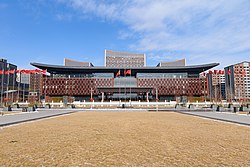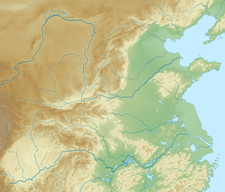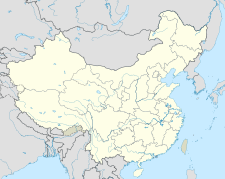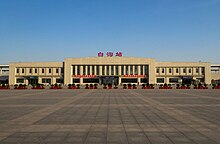Not to be confused with Xiang'an, Xiamen. State-level new area in Hebei, People's Republic of China
| Xiong'an New Area 雄安新区 | |
|---|---|
| State-level new area | |
 Business and Service Convention Center Xiong'an in Rongcheng County Business and Service Convention Center Xiong'an in Rongcheng County | |
 Location of Xiong'an New Area in Hebei Location of Xiong'an New Area in Hebei | |
   | |
| Coordinates: 39°02′55″N 115°54′13″E / 39.0484971°N 115.9037414°E / 39.0484971; 115.9037414 | |
| Country | People's Republic of China |
| Province | Hebei |
| Government | |
| • Party secretary | Zhang Guohua (张国华) |
| Population | |
| • Total | 1,205,440 |
| Time zone | UTC+8 (China Standard Time) |
| GDP (2019) | 21.5 billion RMB |
| Website | xiongan.gov.cn |
| Xiong'an | |||||||||
|---|---|---|---|---|---|---|---|---|---|
| Chinese | 雄安 | ||||||||
| |||||||||

Xiong'an New Area is a state-level new area in the Baoding area of Hebei, China. Established in April 2017, the area is located about 100 kilometers (62 mi) south of Beijing and 50 kilometers (31 mi) east of downtown Baoding. Its main function is to serve as a development hub for the Beijing-Tianjin-Hebei (Jing-Jin-Ji) economic triangle. Additionally, nonessential functions of the Chinese capital are expected to migrate here, including offices of some state-owned enterprises, government agencies, and research and development facilities. The city is planned to be erected by 2035, and to be completed by the middle of the 21st century.
The area covers the counties of Xiong, Rongcheng and Anxin. Its name is a compound of the first elements of the names of two of them: Xiong and Anxin. The construction of the area is described as part of the "millennium strategy" (千年大计). Unlike other "new areas", Xiong'an's development is taking place under the direct oversight of the Central Committee of the Chinese Communist Party (CCP) and the State Council. The temporary government office of the New Area is located in Ao Wei International Hotel (Ao Wei Mansion) in Rongcheng.
Geography

Scope
Xiong'an New Area is located in the North China Plain, between 38°43' and 39°10' north latitude and 115°38' to 116°20' east longitude, 105 km from Beijing and Tianjin, 155 km from Shijiazhuang, 30 km from Baoding, 55 km from Beijing Daxing Airport. It is located at the geometric center of major cities in the Beijing–Tianjin–Hebei region. According to Xu Kuangdi, its location was also motivated by the traditional Chinese philosophy of positioning a city near mountains, rivers, and along axial lines.
Xiong'an's layout mixes urban and natural spaces organized in a manner termed "one center, five subcenters, and multiple nodes". As of 2024, 74,000 new trees had been planted in Xiong'an.
Xiong'an is planned as a Smart City. Its urban design is based on the idea of the "fifteen minute lifecycle" in which all the goods and services needed by an urban person should be available within a fifteen minute walk.
Hydrology
Xiong'an is well-endowed in water features and resources, which is comparatively unusual for north China. The area is located in the Daqing River system of the Haihe River Basin. The average river network density is 0.12–0.23 km per 1 km. Baiyang Lake, northern China's largest freshwater lake, is also included within the new area. The project aims to support restoration of the wetlands surrounding the lake.
Baiyang Lake is Xiong'an's most significant natural feature, including for its cultural and historical significance. It is noted for its scenic beauty. Many Chinese people know of the lake from movies and literature which depict its use by local residents and CCP guerillas during the Second Sino-Japanese War.
Climate
The area is dry and rainy in spring, wet and rainy in summer, cool and dry in autumn, and cold and not snowy in winter. According to the meteorological data of Rongcheng County from 1968 to 2016, the annual average temperature is 12.4 °C, the record high temperature is 41.2°C, the record low temperature is -22.2°C, the annual sunshine hour is 2298.4 hours. The average precipitation is 495.1 mm.
Topography
The area is located in the plain to the east of Taihang Mountain. The terrain gradually decreases from northwest to southeast. The ground elevation is mostly 5 to 26 meters, and the ground slope is less than 2‰.
History

By 2014, China's central government was considering to relocate a number of Beijing's administrative and back office functions to Baoding. According to the memoir Dealing with China by US Treasury Secretary Henry Paulson, Xi Jinping, General Secretary of the Chinese Communist Party, told him personally in July 2014, and said the idea was his "own personal initiative". On 26 February 2014, after hearing reports from Beijing, Tianjin and Hebei, Xi considered the coordinated development of Beijing, Tianjin and Hebei as an important national strategy. After that, rumors such as "Baoding will become a political subcenter", "Baiyangdian City" and "Baiyangdian Free Trade Zone" surfaced on the Internet. Although the "New Urbanization Plan of Hebei Province" issued on 26 March of that year did not mention "subcenter", it was clear that some of Beijing's capital functions would be relieved. At the Central Economic Work Conference held at the end of the year, Xi emphasized that the core problem of the coordinated development of Beijing-Tianjin-Hebei is to relieve Beijing's non-capital functions, reduce Beijing's population density, and promote economic and social development to adapt to the population, resources and environment.
On 10 February 2015, at the 9th meeting of the Central Leading Group for Financial and Economic Affairs, Xi put forward the idea of “duō diǎn yī chéng, lǎo chéng chóngzǔ” (多点一城、老城重组) when considering the Beijing-Tianjin-Hebei Joint Development Plan. Specifically, "One City" (一城) is to study and plan to build a new city outside Beijing. On 2 and 30 April 2015, Xi presided over successive meetings of the Politburo Standing Committee and Politburo of the Chinese Communist Party to discuss the "Beijing-Tianjin-Hebei Coordinated Development Plan", and considered the planning to build a modern new city in a suitable site in Hebei. On 29 February 2016, Premier Li Keqiang presided over a special meeting of the State Council to study the planning and construction of a city, and put forward specific requirements.
On 24 March 2016, Xi chaired a meeting of the Politburo Standing Committee of the Chinese Communist Party, agreeing to name the new city "Xiong'an New Area". On 27 May 2016, the Politburo reviewed the "Report on the Planning and Construction of Beijing's Subcenter and Research on the Establishment of Hebei Xiong'an New District". This was the first time that "Xiong'an" appeared in the title of a report. The Politburo approved the "Implementation Plan for the Study of the Establishment of the Xiong'an New Area in Hebei", and the preparations for the plan were immediately carried out under a high degree of confidentiality.
On 23 February 2017, Xi made on-site inspection to Anxin County and Baiyang Lake, chairing a symposium, listening to reports and delivering an important speech on the planning and construction of Xiong'an New Area.
On 1 April 2017, the Central Committee of the Chinese Communist Party and the State Council issued a notice, deciding to establish the Xiong'an New Area. In the announcement, Xiong'an New Area was positioned as a "millennium plan and a national event". Previously, the information was so confidential that local government didn't know it in advance. In the wake of the announcement, local property prices and shares of construction companies soared. To counter the chaotic property market, authorities froze purchases and closed real estate offices. Xi, during a visit to Helsinki, Finland, gave instructions to prevent real estate speculation. Secretary of the Shenzhen Municipal Party Committee and Mayor Xu Qin was also appointed as the Standing Party Committee of Hebei Province, and then the Deputy Secretary. The same day, on 1 April 2017, the Provincial Government and the Hebei Provincial Party Committee decided to establish the Preparatory Work Committee and the Provisional Party Committee of the Xiong'an New Area. These were transitional institutions, under the authority of the Hebei Provincial Party Committee and the Provincial Government, responsible for organizing, leading, and coordinating the overall development and construction of Xiong'an New Area, performing the functions of organizing, coordinating, supervising political, economic, cultural, social, ecological activities in Xiong'an New Area.
On 2 April, a meeting of leading cadres was held in Rongcheng County. At the meeting, it was agreed that in the next step, management and control should continue to be a top priority, especially on land issues. The government must do a good job of management and control, communicating and propagating at all levels, and managing the power grid. The needs of the people need to be addressed as much as possible, and on the basis of strengthening management and control, it is necessary to accelerate housing relocation, planning and construction. The provincial government has also decided to assign a party cadre committee to temporarily take over the cadre work. On 3 April, the Preparatory Work Committee and Provisional Party Committee of Xiong'an New Area began working in Rongcheng County, temporarily renting Ao Wei International Hotel as an office location.
On 21 June 2017, at the working group meeting on planning and construction of Xiong'an New Area in Hebei Province, Xu Qin, the Governor of Hebei Province, read out the "Reply of the Central Organization Office on issues related to the establishment of management agencies in Xiong'an New Area in Hebei Province". Accordingly, the Xiong'an New Area Working Committee and the Xiong'an New Area Management Committee in Hebei, which were dispatched by the Provincial Party Committee and the Provincial Government, would be established. They were responsible for organizing, leading and coordinating the development and construction of Xiong'an New Area, as well as the overall work on development and construction management of the districts Xiong County, Anxin County, Rongcheng County and surrounding areas. At first, the Party Working Committee and the Xiong'an Management Committee established the Party and Government Office, Department of Reform and Development, Department of Planning and Construction, Department of Public Affairs and Department of Safety Supervision. After that, some agencies like the Public Security were added.
On 22 February 2018, Xi chaired a meeting of the Politburo Standing Committee to hear a report on the planning and preparation work for the construction of the Hung'an New Are, approving the planning framework in principle. On 14 April 2018, "Outline Planning of Hebei Xiong'an New Area" was approved by the Central Committee of the Chinese Communist Party and the State Council. On 21 April, China's official Xinhua News Agency released the planning guidelines for the project, which specify that the city is planned to be erected by 2035 and to be completed by the mid-21st century. According to the guidelines, it is aiming to be a high-level socialist modern city that will be environmentally friendly and be connected by the high-speed rail network that will take 20 minutes to travel to the new Beijing airport and 30 minutes to Beijing and Tianjin. On 25 December, "The Master Plan of Hebei Xiong'an New Area (2018–2035)" was approved by the State Council.
On 4 January 2019, the Standing Committee of the People's Congress of Hebei Province approved the appointment of Liu Guanghui as chairman, Member of the Judiciary Committee, and Judge of the People's Court and Ji Zhiming as the chief prosecutor of the Xiong'an Procuratorate. Xu Yaotong, a professor at the National School of Administration, believed that Xiong'an New Area may be transformed into an administrative unit of Hebei Provincial Government in the future.
On 7 May 2019, resettlement work in Xiong'an officially started. On 2 August 2019, the State Council approved the establishment of the China (Hebei) Pilot Free Trade Zone, which included Xiong'an.
On 29 July 2021, the "Hebei Xiong'an New Area Regulations" (河北雄安新区条例) was adopted at the 24th meeting of the Standing Committee of the Hebei People's Congress, stipulating that the Xiong'an New Area Management Committee is an agency directly under the Government of Hebei Province. This committee exercises economic and social management powers granted by the state and Hebei province. The regulations will be officially implemented on 1 September 2021.
Politics
Xiong'an's development is a state-led project with limited non-state participation. Xiong'an is the product of strong political will and is intended to demonstrate a paradigm shift in China's approach to urban development and to mark the political era of Xi Jinping. It has therefore received the highest levels of state support in terms of planning, resources, and political commitment. Xu Kuangdi is Xi's lead advisor for the development of Xiong'an, as of at least 2023.
Administrative division
The planning scope of the Xiong'an New Area covers the 3 counties of Xiong, Rongcheng, and Anxin in Hebei Province and some surrounding areas. The planning and construction will take a specific area as the starting area (about 100 square kilometers) for development. The medium-term development area is about 200 square kilometers and the long-term area is about 2,000 square kilometers.
| Map | |||||||||||||
|---|---|---|---|---|---|---|---|---|---|---|---|---|---|
 Baiyang
BaiyangLake Anxin County Xiong County Rongcheng County | |||||||||||||
| Division code | English name | Simp. Chinese | Pinyin | Area in km | Seat | Postal code | Divisions | ||||||
| Towns | Townships | Residential communities | Villages | ||||||||||
| Xiong'an New Area | 雄安新区 | Xióng'ān Xīnqū | 106.46 | Rongcheng County | 20(+2) | 9(+2) | 16 | 557(+110) | |||||
| 130629 | Rongcheng County | 容城县 | Róngchéng Xiàn | 311 | Rongcheng (容城镇) | 071700 | 5 | 3 | 4 | 127 | |||
| 130632 | Anxin County | 安新县 | Ānxīn Xiàn | 728 | Anxin (安新镇) | 071600 | 9 | 3(+1) | 5 | 207(+16) | |||
| 130638 | Xiong County | 雄县 | Xióng Xiàn | 513 | Xiongzhou (雄州镇) | 071800 | 6(+2) | 3(+1) | 7 | 223(+94) | |||
| |||||||||||||
Transportation
Railway




Xiong'an railway station, on the Beijing–Xiong'an intercity railway, was opened on 27 December 2020.
Baigou railway station and Baiyangdian railway station, on Tianjin–Baoding intercity railway, are within reach.
Airport
Beijing Daxing International Airport (opened in 2019) serves the area. It takes approximately 20 minutes to reach from Xiong'an by high speed rail.
Expressway
It is currently served by two national expressways, G45 and G18, as well as two regional expressways, S3601 and S3700.
Economy
Since its establishment, various state-owned enterprises (SOEs) have begun constructing offices in the area. Additionally, several research centers and satellite branches of Beijing-based universities are planning to open in the area by 2025. Foreign investment is not being sought; China intends for Xiong'an to be an economic centre for state-owned enterprises and other domestic enterprises.
As of September 2022, the area reported ¥400 billion ($57 billion) in completed investment. The development of Xiong'an is funded by the state through fiscal allocation, state bank loans, SOE investment, and intercity partnerships. Xiong'an Group, under control of the Hebei Provincial People's Government, has been created as an investment fund for the area, backed partially by the China Development Bank.
State media describes Xiong'an as the future "Shenzhen of the north".
Real estate
A flood of capital, much of it from Beijing, has been searching for properties in Xiong'an to invest, causing real estate price in this area to skyrocket rapidly since the announcement of the New Area. In 2017, local government imposed a temporary ban on new property sales. New household registrations in some places were also stopped, and many real estate speculators were arrested by the police that year as well. The model of real estate development in the New Area may use public housing in Singapore for reference, according to a senior officer's interview on People's Daily on 5 April 2017.
Acquisition of land for residential development in Xiong'an has used an approach termed the "new urbanization dividend distribution mechanism." Farmers whose land is acquired for future residential development become shareholders of urban development with the government and developers. Via the new urbanization dividend distribution mechanism, they receive benefits annually.
On 21 September 2023, the housing administration center of Xiong'an announced that all homes in the city must be built before they are sold, a major departure from the model throughout China where customers could buy houses from property developers before they were built.
Notes
References
- "新任河北省委常委张国华任雄安新区党工委书记、管委会主任(图|简历)". Economic Daily (经济日报). December 30, 2020.
- "雄安社会经济概况". Xiong'an New Area Government. Retrieved February 27, 2023.
- "河北雄安新区2019年GDP披露 为215亿元". March 15, 2020.
- "国新办公布61个重大国家战略常用关键词英文译法". June 23, 2020. Archived from the original on May 9, 2021.
5.雄安新区 Xiong'an New Area
- "Xiongan is Xi Jinping's pet project". The Economist. May 18, 2023. ISSN 0013-0613. Retrieved September 21, 2023.
- ^ Hu, Richard (2023). Reinventing the Chinese City. New York: Columbia University Press. ISBN 978-0-231-21101-7.
- China to create Xiongan New Area in Hebei, Xinhua, 1 April 2017
- 雄安不眠夜:容城奥威大厦灯火通明. thepaper.cn. April 3, 2017.
- ^ "雄安地理环境和气候特征". Xiong'an New Area Government. January 19, 2021.
- ^ Curtis, Simon; Klaus, Ian (2024). The Belt and Road City: Geopolitics, Urbanization, and China's Search for a New International Order. New Haven and London: Yale University Press. doi:10.2307/jj.11589102. ISBN 9780300266900. JSTOR jj.11589102.
- "China to build massive city southwest of Beijing". Asia Nikkei. April 3, 2017.
- McCarthy, Simone; Gan, Nectar (August 18, 2023). "Xi Jinping is building a dream city. Devastating floods raise questions about his plan". CNN News. Retrieved January 28, 2024.
- Paulson, Henry (2015). Dealing with China: An Insider Unmasks the New Economic Superpower. Hachette UK. ISBN 978-1-4555-0422-0.
The central government is planning to relocate a number of administrative or back office functions to Baoding to relieve congestion in the capital and perhaps improve the economy in the outlying areas. With the proposed Beijing Tianjin-Hebei megalopolis—or Jing-Jin-Ji, as it's popularly known, after the Chinese names of these cities—Xi Jinping sees a regional approach to solving problems as one of his legacies. As he told me simply in July 2014, "This was my own personal initiative."
- ^ "河北雄安新区探路:对标深圳浦东,京津冀协同发展"试金石"". The Paper. April 2, 2017.
- ^ "张高丽就设立雄安新区接受新华社记者采访". Xinhua News Agency. April 15, 2017. Archived from the original on July 24, 2021. Retrieved August 9, 2021.
- ^ "雄安规划干货首次对外公开:新区选址曾有13个方案". Caijing. April 27, 2018. Archived from the original on April 30, 2018.
- "详解雄安新区决策、选址经过". Caixin. April 13, 2017.
- ^ "受权发布:中共中央、国务院决定设立河北雄安新区". Xinhua News Agency. April 1, 2017.
- "习近平时隔近两年再赴雄安". Xinhua News Agency. January 16, 2019.
- Ma, Tianjie (May 19, 2017). "China's new megacity: the anti-Beijing". Foreign Policy. Retrieved August 8, 2023.
- 雄安新区成立前保密严格 筹委会官员昨“一对一”调研重点小镇. National Business Daily. April 3, 2017.
- Tang, Aileen (April 3, 2017). "Within hours, plans for a quiet corner of China send home prices soaring". New York Times. Retrieved August 9, 2023.
- "河北将成立雄安新区筹备工作委员会及临时党委". The Paper. April 2, 2017 – via Sina.
- "雄安新区临时党委接管干部工作 即日起冻结人事变动". 中国经营网. April 2, 2017 – via Ifeng.
- "独家探访河北雄安新区筹委会办公地:租了整栋楼,已完成入驻". The Paper. April 3, 2017. Archived from the original on April 3, 2017.
- ^ "河北雄安新区管理机构获中央编办批复". Reference News (参考消息). June 22, 2017. Archived from the original on September 14, 2018. Retrieved September 14, 2018.
- "管理机构获中央编办批复". Xinhua News Agency. June 23, 2017. Archived from the original on September 3, 2019.
- "雄安新区首任公安局长到位,雄安公安局将承担治安重任". 安新吧. June 11, 2018. Archived from the original on September 14, 2018. Retrieved September 14, 2018 – via Sohu.
- "中共中央国务院关于对《河北雄安新区规划纲要》的批复". People Daily (人民日报). April 21, 2018. Archived from the original on April 21, 2018. Retrieved April 21, 2018.
- Hu, Richard (May 22, 2018). "Xiong'an, Xi Jinping's new city-making machine turned on". The Conversation. Retrieved May 5, 2023.
- "国务院关于河北雄安新区总体规划(2018—2035年)的批复". Chinese Government. Retrieved January 2, 2019.
- "雄安新区人事任命再传新消息 :"法检两长"上任". Sina. January 5, 2019. Archived from the original on January 6, 2019. Retrieved January 6, 2019.
- "雄安新区正式启动征迁安置工作". Beijing News (新京报). May 7, 2019 – via Sina.
- "国务院关于印发6个新设自由贸易试验区总体方案的通知". Government of China. August 26, 2019. Archived from the original on August 26, 2019. Retrieved August 26, 2019.
- "国务院关于同意新设6个自由贸易试验区的批复". Government of China. August 26, 2019. Archived from the original on August 30, 2019. Retrieved August 26, 2019.
- "河北立法规定雄安新区管委会是河北省政府派出机构". Xinhua News Agency. July 29, 2021.
- "《河北雄安新区条例》明确雄安新区管委会行使国家和省赋予的省级经济社会管理权限 9月1日起正式实施". China National Radio. July 30, 2021.
- 国家统计局统计用区划代码 Archived 7 April 2012 at the Wayback Machine
- 《保定经济统计年鉴2011》
- 《中国民政统计年鉴2012》
- "Beijing-Xiongan high-speed railway starts service". Retrieved December 27, 2020.
- ^ Stokols, Andrew (January 22, 2023). "China's Futuristic City Is a Test of Its Planning Power". Foreign Policy. Retrieved September 21, 2023.
- ^ Chatwin, Jonathan (2024). The Southern Tour: Deng Xiaoping and the Fight for China's Future. Bloomsbury Academic. p. 129. ISBN 9781350435711.
- 雄安新区“抢房”亲历记:24小时内的冰火两重天, 2017-04-02, 大公网
- "China freezes property sales in new economic zone in Hebei". Reuters. April 2, 2017.
- "雄安新区三县楼市交易冻结". Xinhua News Agency. April 3, 2017. Archived from the original on July 31, 2021. Retrieved August 9, 2021.
- "雄安新区探访:当地居民高价抛售房产 中介现场被警方带走". The Economic Observer (经济观察报). April 4, 2017 – via Sina.
- 雄安新区或借鉴新加坡模式. China Youth Daily. 12 April 2017.
- "China Tests New Property Model in Xi's Flagship City Amid Crisis". Bloomberg News. September 21, 2023. Retrieved September 21, 2023.
External links
| New Areas in China | |
|---|---|
| State-level | |
| East Coast | |
| Central China | |
| Northeast China | |
| Western China | |
| Defunct | |
| Note: with " * " are administrative divisions registered in the Ministry of Civil Affairs while other New Areas are established as economic management areas. | |
| Major regions and cities of China | |||||||||||||||||||||||||||||||||||||||||||||||||||||||||||||
|---|---|---|---|---|---|---|---|---|---|---|---|---|---|---|---|---|---|---|---|---|---|---|---|---|---|---|---|---|---|---|---|---|---|---|---|---|---|---|---|---|---|---|---|---|---|---|---|---|---|---|---|---|---|---|---|---|---|---|---|---|---|
| National megalopolises |
| ||||||||||||||||||||||||||||||||||||||||||||||||||||||||||||
| Regions | |||||||||||||||||||||||||||||||||||||||||||||||||||||||||||||
| Administrative divisions | |||||||||||||||||||||||||||||||||||||||||||||||||||||||||||||
| Cities | |||||||||||||||||||||||||||||||||||||||||||||||||||||||||||||
| Capitals | |||||||||||||||||||||||||||||||||||||||||||||||||||||||||||||
| |||||||||||||||||||||||||||||||||||||||||||||||||||||||||||||